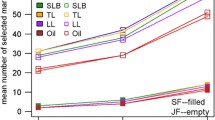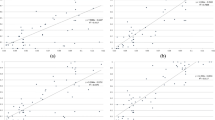Abstract
Knowledge about the forces generating and conserving linkage disequilibrium (LD) is important for drawing conclusions about the prospects and limitations of association mapping. The objectives of our research were to examine the importance of (1) selection, (2) mutation, and (3) genetic drift for generating LD in a typical maize breeding program. We conducted computer simulations based on genotypic data of Central European maize open-pollinated varieties which have played an important role as founders of the European flint heterotic group. The breeding scheme and the dimensioning underlying our simulations reflect essentially the maize breeding program of the University of Hohenheim. Results suggested that in a plant breeding program of the examined dimension and breeding scheme, genetic drift and selection are major forces generating LD. The currently used population-based association mapping tests do not explicitly correct for LD caused by these two forces. Therefore, increased type I error rates are expected if these tests are applied to plant breeding populations. As a consequence, we recommend to use family-based association tests for association mapping approaches in plant breeding populations.


Similar content being viewed by others
References
Andersen JR, Lübberstedt T (2003) Functional markers in plants. Trends Plant Sci 8:554–560
Arbelbide M, Yu J, Bernardo R (2006) Power of mixed-model QTL mapping from phenotypic, pedigree and marker data in self-pollinated crops. Theor Appl Genet 112:876–884
Bulmer MG (1971) The effect of selection on genetic variability. Am Nat 105:201–211
Calafell F, Grigorenko EL, Chikanian AA, Kidd KK (2001) Haplotype evolution and linkage disequilibrium: a simulation study. Hum Hered 51:85–96
Cartea ME, Revilla P, Butrón A, Malvar A, Ordás A (1999) Do second cycle maize inbreds preserve the European flint heterotic group? Crop Sci 39:1060–1064
Corder EH, Saunders AM, Risch NJ, Strittmatter WJ, Schmechel DE, Gaskell PC, Rimmler JB, Locke PA, Conneally PM, Schmader KE, Small GW, Roses AD, Haines JL, Pericak-Vance MA (1994) Protective effect of apolipoprotein E type 2 allele for late onset alzheimer disease. Nat Genet 7:180–184
Drake JW, Charlesworth B, Charlesworth D, Crow JF (1998) Rates of spontaneous mutation. Genetics 148:1667–1686
Dudley JW, Lambert RJ (1992) Ninety generations of selection for oil and protein in maize. Maydica 37:81–87
Farnir F, Coppieters C, Arranz J-J, Berzo P, Cambisano N, Grisart B, Karim L, Marcq F, Moreau L, Mni M, Nezer C, Simon P, Vanmanshoven P, Wagenaar D, Georges M (2000) Extensive genome-wide linkage disequilibrium in cattle. Genome Res 10:220–227
Flint-Garcia SA, Thornsberry JM, Buckler ES (2003) Structure of linkage disequilibrium in plants. Annu Rev Plant Biol 54:357–374
Guo SW, Thompson EA (1992) Performing the exact test of Hardy–Weinberg proportion for multiple alleles. Biometrics 48:361–372
Haldane JBS, Waddington CH (1931) Inbreeding and linkage. Genetics 16:357–374
Hallauer AR, Miranda JB (1981) Quantitative genetics in maize breeding. Iowa State University Press, Ames
Hill WG, Robertson A (1968) Linkage disequilibrium in finite populations. Theor Appl Genet 38:226–231
Iles MM, Bishop DT (1998) The effect of population structure and mutation rate on linkage disequilibrium. Am J Hum Genet 63:A42
Kerem B, Rommens JB, Buchanan JA, Markievicz D, Cox DK, Chakravarti A, Buchwald M, Tsui LC (1989) Identification of the cystic fibrosis gene: genetic analysis. Science 245:1073–1080
Longin CFH, Utz HF, Reif JC, Schipprack W, Melchinger AE (2006) Hybrid maize breeding with doubled haploids: I. One-stage versus two-stage selection for testcross performance. Theor Appl Genet 112:903–912
Maurer HP, Melchinger AE, Frisch M (2004) Plabsoft: Software for simulation and data analysis in plant breeding. Poster Abstract XVIIth EUCARPIA General Congress, Tulln, Austria
Maurer HP, Knaak C, Melchinger AE, Ouzunova M, Frisch M (2006) Linkage disequilibrium between SSR markers in six pools of elite lines of an European breeding program for hybrid maize. Maydica 51:269–279
Mihaljevic R, Schön CC, Utz HF, Melchinger AE (2005) Correlations and QTL correspondence between line per se and testcross performance for agronomic traits in four populations of European maize. Crop Sci 45:114–122
Nordborg M, Borevitz JO, Bergelson J, Berry CC, Chory J, Hagenblad J, Kreitman M, Maloof JN, Noyes T, Oefner PJ, Stahl EA, Weigel D (2002) The extent of linkage disequilibrium in Arabidopsis thaliana. Nat Genet 30:190–193
Oettler G, Schnell FW, Utz HF (1976) Die westdeutschen Getreide- und Kartoffelsortimente im Spiegel ihrer Vermehrungsflächen. In: Alleweldt G (ed) Hohenheimer Arbeiten. Schriftenreihe der Universität Hohenheim Reihe: Pflanzliche Produktion. Verlag Eugen Ulmer, Stuttgart
Pandey S, Diallo AO, Islam TMT, Deutsch J (1987) Response to full-sib selection in four medium maturity maize populations. Crop Sci 27:617–622
Parisseaux B, Bernardo R (2004) In silico mapping of quantitative trait loci in maize. Theor Appl Genet 109:508–514
R Development Core Team (2004) R: A language and environment for statistical computing. Vienna, Austria
Reif JC, Hamrit S, Heckenberger M, Schipprack W, Maurer HP, Bohn M, Melchinger AE (2005a) Genetic structure and diversity of European flint maize populations determined with SSR analyses of individuals and bulks. Theor Appl Genet 111:906–913
Reif JC, Hamrit S, Heckenberger M, Schipprack W, Maurer HP, Bohn M, Melchinger AE (2005b) Trend of genetic diversity among European maize cultivars and their parental components during the past 50 years. Theor Appl Genet 111:838–845
Robinson HF, Cockerham CC, Moll RH (1960) Studies on estimation of dominance variance and effects of linkage bias. In: Kempthorne O (ed) Biometrical genetics. Pergamon, New York, pp 171–177
Schnell FW (1992) Maiszüchtung und die Züchtungsforschung in der Bundesrepublik Deutschland. Vorträge Pflanzenzüchtung 22:27–44
Shendure J, Mitra RD, Varma C, Church GM (2004) Advanced sequencing technologies: methods and goals. Nat Rev Genet 5:335–344
Stich B, Melchinger AE, Frisch M, Maurer HP, Heckenberger M, Reif JC (2005) Linkage disequilibrium in European elite maize germplasm investigated with SSRs. Theor Appl Genet 111:723–730
Stromberg LD, Compton WA (1989) Tencycles of full-sib selection in maize. Crop Sci 29:1170–1172
Terwilliger JD, Zöllner S, Laan M, Pääbo S (1998) Mapping genes through the use of linkage disequilibrium generated by genetic drift: ’drift mapping’ in small populations with no demographic Expansion. Hum Hered 48:138–154
Thornsberry JM, Goodman MM, Doebley J, Kresovich S, Nielsen D, Buckler ES (2001) Dwarf8 polymorphisms associate with variation in flowering time. Nat Genet 28:286–289
Vigouroux Y, Jaqueth JS, Matsuoka Y, Smith OS, Beavis WD, Smith JSC, Doebley J (2002) Rate and pattern of mutation at microsatellite loci in maize. Mol Biol Evol 19:1251–1260
Yu J, Arbelbide M, Bernardo R (2005) Power of in silico QTL mapping from phenotypic, pedigree, and marker data in a hybrid breeding program. Theor Appl Genet 110:1061–1067
Yu J, Pressoir G, Briggs WH, Bi IV, Yamasaki M, Doebley JF, McMullen MD, Gaut BS, Nielsen DN, Holland JB, Kresovich S, Buckler ES (2006) A unified mixed-model method for association mapping that accounts for multiple levels of relatedness. Nat Genet 2:203–208
Zaykin D, Zhivotovsky L, Weir BS (1995) Exact tests for association between alleles at arbitrary numbers of loci. Genetica 96:169–178
Zhang S, Zhang K, Li J, Sun F, Zhao H (2001) Test of association for quantitative traits in general pedigrees: the quantitative pedigree disequilibrium test. Genet Epidemiol 21:370–375
Acknowledgments
This research was conducted within the Breeding and Informatics (BRAIN) project of the Genome Analysis of the Plant Biological System (GABI) initiative (http://www.gabi.de). Financial support for B. Stich was provided by a grant from the German National Academic Foundation. The authors appreciate the editorial work of Dr. J. Muminović, whose suggestions considerably improved the style of the manuscript. The authors thank two anonymous reviewers for their valuable suggestions.
Author information
Authors and Affiliations
Corresponding author
Additional information
Communicated by G. Wenzel.
Rights and permissions
About this article
Cite this article
Stich, B., Melchinger, A.E., Piepho, HP. et al. Potential causes of linkage disequilibrium in a European maize breeding program investigated with computer simulations. Theor Appl Genet 115, 529–536 (2007). https://doi.org/10.1007/s00122-007-0586-1
Received:
Accepted:
Published:
Issue Date:
DOI: https://doi.org/10.1007/s00122-007-0586-1




